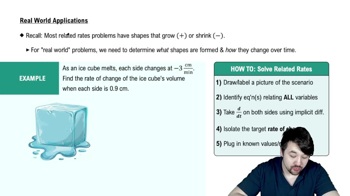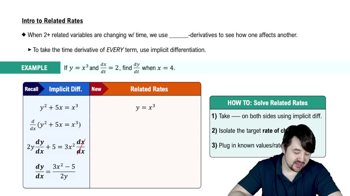Table of contents
- 0. Functions7h 52m
- Introduction to Functions16m
- Piecewise Functions10m
- Properties of Functions9m
- Common Functions1h 8m
- Transformations5m
- Combining Functions27m
- Exponent rules32m
- Exponential Functions28m
- Logarithmic Functions24m
- Properties of Logarithms34m
- Exponential & Logarithmic Equations35m
- Introduction to Trigonometric Functions38m
- Graphs of Trigonometric Functions44m
- Trigonometric Identities47m
- Inverse Trigonometric Functions48m
- 1. Limits and Continuity2h 2m
- 2. Intro to Derivatives1h 33m
- 3. Techniques of Differentiation3h 18m
- 4. Applications of Derivatives2h 38m
- 5. Graphical Applications of Derivatives6h 2m
- 6. Derivatives of Inverse, Exponential, & Logarithmic Functions2h 37m
- 7. Antiderivatives & Indefinite Integrals1h 26m
- 8. Definite Integrals3h 25m
4. Applications of Derivatives
Related Rates
Problem 3.11.37
Textbook Question
Water is drained out of an inverted cone that has the same dimensions as the cone depicted in Exercise 36. If the water level drops at 1 ft/min, at what rate is water (in ft³/min) draining from the tank when the water depth is 6 ft?
 Verified step by step guidance
Verified step by step guidance1
Identify the relationship between the volume of the cone and the height of the water. The volume V of a cone is given by the formula V = (1/3)πr²h, where r is the radius and h is the height.
Since the cone is inverted, express the radius r in terms of the height h using similar triangles. If the full height of the cone is H and the full radius is R, then r/h = R/H, leading to r = (R/H)h.
Substitute the expression for r into the volume formula to express V solely in terms of h: V = (1/3)π((R/H)h)²h = (1/3)π(R²/H²)h³.
Differentiate the volume V with respect to time t using the chain rule, noting that dV/dt = (dV/dh)(dh/dt). Here, dh/dt is given as -1 ft/min (the negative sign indicates the water level is dropping).
Evaluate dV/dt at the specific height h = 6 ft by substituting h into the differentiated volume equation and using the known value of dh/dt.
Recommended similar problem, with video answer:
 Verified Solution
Verified SolutionThis video solution was recommended by our tutors as helpful for the problem above
Video duration:
3mPlay a video:
Was this helpful?
Related Videos
Related Practice






